

Energy Storage. Is This the Key to Vastly Better Batteries? Researchers are experimenting with a handful of ideas that could make batteries vastly better than they are today, which could lead to more affordable electric cars and cheaper ways to store solar power to use at night.
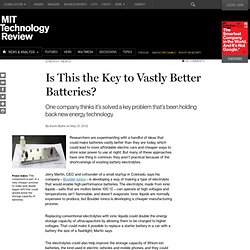
But many of these approaches have one thing in common: they aren’t practical because of the shortcomings of existing battery electrolytes. Jerry Martin, CEO and cofounder of a small startup in Colorado, says his company—Boulder Ionics—is developing a way of making a type of electrolyte that would enable high-performance batteries. The electrolyte, made from ionic liquids—salts that are molten below 100 ⁰C—can operate at high voltages and temperatures, isn’t flammable, and doesn’t evaporate. Ionic liquids are normally expensive to produce, but Boulder Ionics is developing a cheaper manufacturing process. Semi-Solid Lithium Rechargeable Flow Battery. Storing green electricity as natural gas. Renewable electricity can be transformed into a substitute for natural gas.
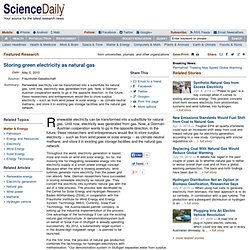
Until now, electricity was generated from gas. Now, a German-Austrian cooperation wants to go in the opposite direction. In the future, these researchers and entrepreneurs would like to store surplus electricity -- such as from wind power or solar energy -- as climate-neutral methane, and store it in existing gas storage facilities and the natural gas network. Throughout the world, electricity generation is based more and more on wind and solar energy. Electric car battery breakthrough. Phinergy's Recyclable Aluminum-Air Battery Could Power Electric Vehicles for Thousands of Miles. Range anxiety is a much-discussed concern among drivers—and potential drivers—of electric vehicles, and in attempt to thwart it, automakers are trying to install more EV charging stations, offering free gas-powered rentals for longer trips and, of course, developing batteries with a substantially longer range.
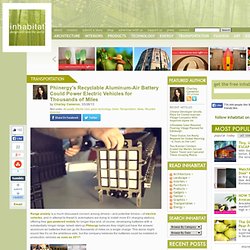
Israeli start-up Phinergy believes they might just have the answer: aluminum-air batteries that can go for thousands of miles on a single charge. This alone might sound like it’s on the ambitious side, but the company believes the batteries could be installed in production vehicles as soon as 2017! CAES To Grow Dramatically Over The Next Decade. Clean Power Published on August 27th, 2013 | by Nicholas Brown According to Navigant Research, the compressed air energy storage industry is forecast to grow drastically during the next 10 years.
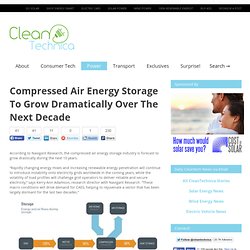
“Rapidly changing energy mixes and increasing renewable energy penetration will continue to introduce instability onto electricity grids worldwide in the coming years, while the volatility of load profiles will challenge grid operators to deliver reliable and secure electricity,” says Kerry-Ann Adamson, research director with Navigant Research. “These macro conditions will drive demand for CAES, helping to rejuvenate a sector that has been largely dormant for the last two decades.” Apart from the above factors, it’s important to note that coal, nuclear, and thermal natural gas power plants are slow to adjust and unable to meet electricity demand on their own, hence the use of peaking power plants. Tags: CAES industry, CAES industry growth, future of CAES, Navigant Research CAES.
Plant root used to create eco-friendly lithium-ion battery. Researchers have found an eco-friendly alternative to the metal ores currently favored in the electrodes of lithium-ion batteries. The new non-toxic and sustainable battery uses purpurin, a red/yellow dye extracted from the root of the madder plant that has been used for dying cloth for at least 3,500 years – meaning the substance can simply be grown rather than mined. Currently, lithium cobalt oxide (LiCoO2) is the material of choice for forming the cathode in Li-ion batteries. However, mining the cobalt and combining it with lithium at high temperatures to form the cathode is an expensive and energy-intensive process. Sometimes storing electricity makes no (energetic) sense.
Two of the major renewable energy sources, wind and solar power, are intermittent in that they can't always be relied on for power.
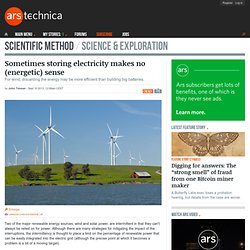
Although there are many strategies for mitigating the impact of the interruptions, the intermittency is thought to place a limit on the percentage of renewable power that can be easily integrated into the electric grid (although the precise point at which it becomes a problem is a bit of a moving target). One approach to intermittency is to store electricity from these sources for use when they're not active.
GE even offers an integrated wind energy/battery system that's meant to do precisely that. But a new analysis by Stanford researchers suggests that this approach might be misguided. Researchers create super-efficient, long-lasting battery from wood. Batteries usually contain harsh chemicals that make them less than environmentally friendly, but a new research project out of the University of Maryland seeks to change that, at least on the small-scale.
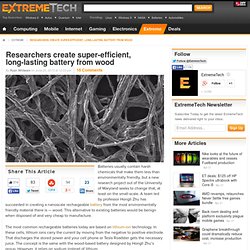
A team led by professor Hongli Zhu has succeeded in creating a nanoscale rechargeable battery from the most environmentally friendly material there is — wood. This alternative to existing batteries would be benign when disposed of and very cheap to manufacture. The most common rechargeable batteries today are based on lithium-ion technology. In these cells, lithium ions carry the current by moving from the negative to positive electrode. That discharges the stored power and your cell phone or Tesla Roadster gets the necessary juice. But why bother with wood? After being coated with a thin layer of tin, the fibers can maintain the battery’s integrity for over 400 charging cycles — that’s longer than many lithium-ion cells, and by far the most of any nanoscale battery.